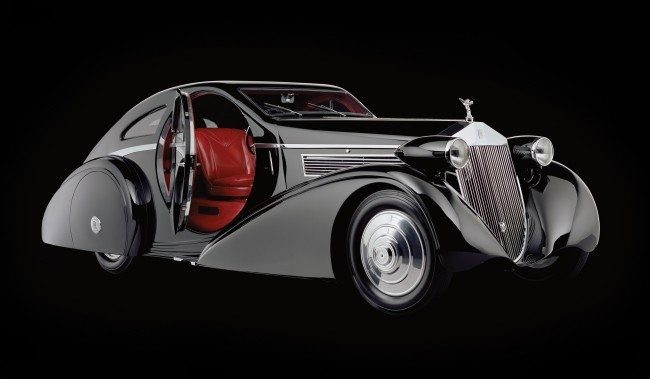The 1920s and 1930s were a golden age for custom coachbuilding, allowing the affluent to express their individuality with one-of-a-kind vehicles. While renowned coachbuilders like Waterhouse, Figoni & Falaschi, and Murphy were the usual choices for luxury marques, a lesser-known Belgian company, Jonckheere Carrossiers, created arguably the most striking Rolls Royce Phantom ever: the 1925 Phantom I Jonckheere Coupe.
The Birth of a Legend: From Hooper Cabriolet to Jonckheere Masterpiece
Launched in May 1925, the Rolls Royce Phantom I (then known as the “New Phantom”) succeeded the Silver Ghost. Featuring a slightly larger engine with overhead valves and crucial front-wheel brakes, the Phantom I chassis provided the foundation for Jonckheere’s transformative vision. Originally a stately Hooper Cabriolet destined for Detroit, this particular Phantom I was resold to the Raja of Nanpara before eventually finding its way to Jonckheere’s workshop in Belgium in 1934.
Jonckheere’s Audacious Design: Reimagining the Rolls Royce Aesthetic
Henri Jonckheere, established as a carriage-builder in 1881, transitioned to automobiles in the early 20th century. His son, Joseph, furthered the company’s success with bus bodies. However, it was the reimagining of the Rolls Royce Phantom I that cemented their legacy. Inspired by French coachbuilders like Saoutchik and Figoni, Jonckheere created a fashionably aerodynamic fastback body for the Phantom I.
A Symphony of Style: Streamlined Elegance and Innovative Features
The Jonckheere Coupe boldly modified the traditional Rolls Royce vertical grill, a daring move for the time. Bullet-shaped headlights, flowing fenders, and a prominent vertical tailfin contributed to its sleek silhouette. The most striking features were the large, round doors, a unique design element requiring a cleverly engineered two-piece scissor-split window system. At nearly 20 feet long, the Jonckheere Coupe is potentially the largest 2-door coupe ever created. Sadly, a fire destroyed Jonckheere’s records, leaving the designer and commissioner of this masterpiece unknown.
From Concours Glory to “Royal Rolls” Spectacle
Despite its polarizing design, the Jonckheere Coupe won the Prix d’Honneur at the 1936 Cannes Concours d’Elegance. After arriving in the US before WWII, it fell into disrepair before being rediscovered and restored, albeit with a flamboyant gold paint job and a fabricated history linking it to King Edward VIII. This “Royal Rolls” was then used as a paid attraction, a far cry from its concours days.
Resurrection and Recognition: The Peterson Automotive Museum Restoration
In 1991, this unique Rolls Royce Phantom sold for $1.5 million to a Japanese collector. The Peterson Automotive Museum acquired it in 2001 and meticulously restored it to its former glory. Research revealed that the original color was not white, gold, or even the robin’s egg blue found underneath. Black was chosen to emphasize the car’s dramatic curves and proportions.
Driving the Icon: A Unique Experience
Driving the Rolls Royce Phantom I Jonckheere Coupe is a demanding but rewarding experience. Its size and weight require significant effort at low speeds, double-clutching during gear changes, and ample braking distance. The low ground clearance and long rear overhang limit maneuverability, while the sloping roof compromises rear passenger headroom.
A Timeless Masterpiece: The Enduring Legacy of the Jonckheere Coupe
Despite its driving challenges, the Jonckheere Coupe’s true purpose is to make a statement. It’s a rolling sculpture, a testament to the artistry of custom coachbuilding, and a unique chapter in the history of the Rolls Royce Phantom. Since its restoration, it has graced prestigious concours events, earning accolades such as the Lucius Beebe Trophy for the finest Rolls Royce and the People’s Choice Award at Meadowbrook. The Rolls Royce Phantom I Jonckheere Coupe is a testament to the enduring allure of automotive art deco design.
